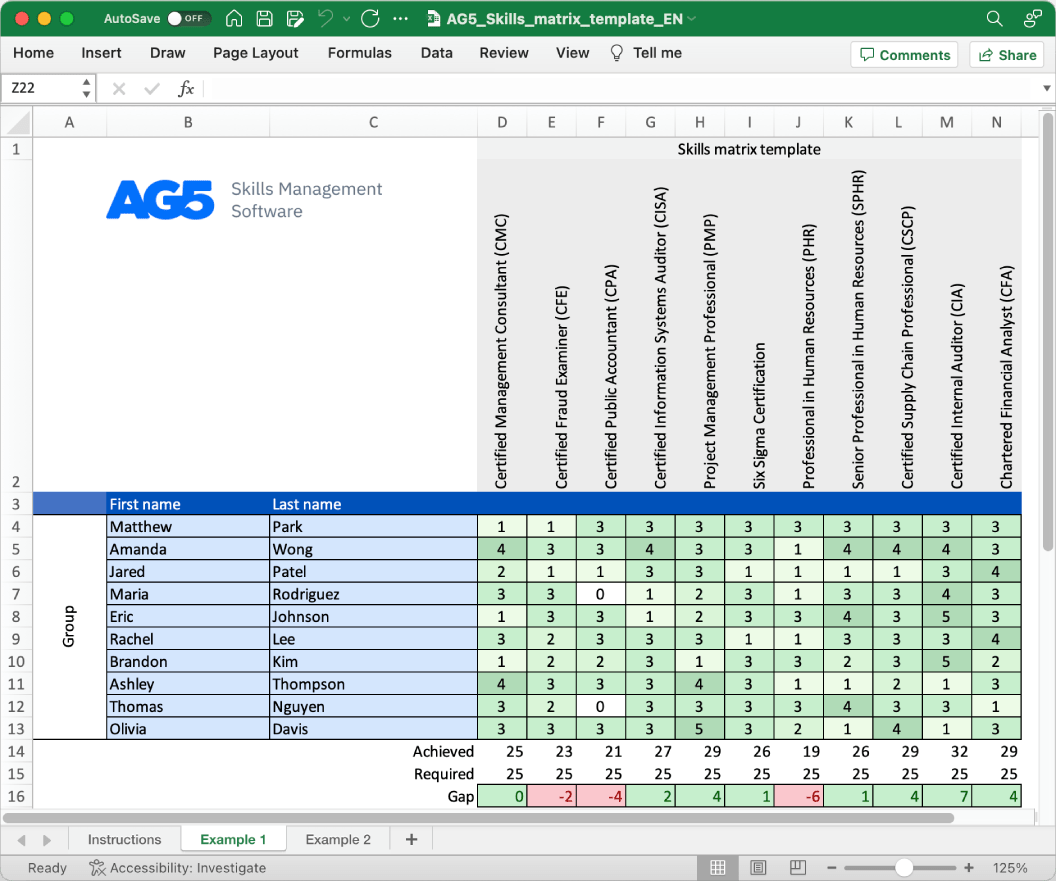Structural engineering skills matrix template
A skills matrix template is a tool that organizations can use to effectively manage and assess the skills and certification statuses of individual employees or teams.
Download your free template here

Overview Copied
A skills matrix template is a tool that organizations can use to effectively manage and assess the skills and certification statuses of individual employees or teams.
For example, you can use this structural engineering skills matrix to ensure that your employees are proficient in structural design software like SAP2000 or Revit, or hold active SE licenses or ACI certifications.
Technical analysis and design
- Finite Element Analysis (FEA)
- Dynamic Structural Analysis (vibration and damping)
- Seismic Retrofitting Techniques
- Structural Engineer (SE) License
- Stability Analysis (buckling and lateral-torsional instability)
Construction and materials
- Reinforced Concrete Detailing (rebar placement, cover requirements)
- Structural Steel Connections Design (bolted, welded connections)
- AWS Certified Welding Inspector (CWI)
- Precast and Prefabricated Structures Design
- ACI Concrete Field Testing Technician – Grade I
Project management and safety
- Structural Health Monitoring (SHM) Systems
- Certified Safety Professional (CSP)
- OSHA 30-Hour Construction Safety Certification
- Risk Assessment and Mitigation for Structural Failures
- ASCE Certificate in Structural-Condition Assessment of Existing Structures
Benefits Copied
Using a structural engineering skills matrix template can benefit your teams in various ways. Among them:
- Enhanced resource allocation. By mapping skills and certifications, you can assign the right engineers to projects that align with their expertise
- Streamlined training and development. By identifying skill gaps in your teams, you can target specific training programs or certifications that will, ensure continuous professional growth and alignment with industry standards like ACI or AISC
- Improved project planning. A skills matrix provides you with a clear view of team strengths and weaknesses, which you can use to anticipate potential bottlenecks
How can I customize my materials requirements planning skills matrix to fit a specific team? Copied
The scope of a structural engineering skills matrix can be as large or small as you choose. For example, it could cover your entire organization – or only those focused on project management and safety.
To customize a skills matrix to your needs, you should:
- Define focus. Clarify if the skills matrix pertains to an entire department or specific roles within it
- Identify key skills. List essential competencies for each role or area of operation
- Establish proficiency levels. Define skill proficiency levels, aligning them with job requirements
- Set evaluation criteria. Create a clear evaluation process, considering on-the-job performance and training qualifications
- Regularly review and update. Ensure regular reviews to adapt to evolving roles, technologies, and organizational goals
Do you require a skill or certification that is not included in the above list? No problem! You can easily add additional certifications yourself to customize the skills matrix to your organization’s needs. You can also add your own employees and how they score against each certification.
Not sure what scoring system to use? Check out our “Ultimate Guide to Creating an Excel Skills Matrix.”
Looking for alternatives to Excel for your skills matrix templates? Copied
AG5’s skills management software enables you to visualize and close skills gaps across your organization – no need for complicated Excel spreadsheets. You’ll use intuitive skills matrices that bring together skills data and job requirements – and are always up to date.
FAQs Copied
-
What are the benefits of using a structural engineering skills matrix?
-
Is this structural engineering skills matrix free to download?
-
How do I use a structural engineering skills matrix?
-
What if I want to take my skills management to the next level?
Author Copied
Revisions Copied
Tired of managing skills in Excel?
Say goodbye to Excel matrices. Start using AG5’s plug and play skill matrix software.
Recognized by G2 for Excellence in Skills Management

